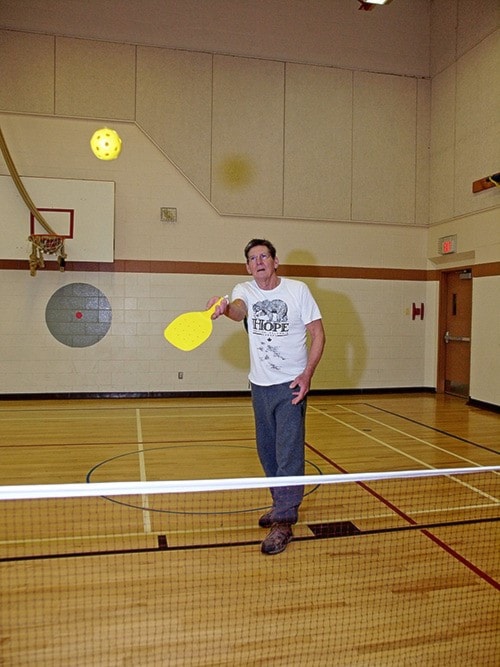Pickleball.
The name of the game may conjure up thoughts of a bumpy, green ball with a spicy aroma. But no... it’s just a plastic ball with holes in it — a whiffle ball — that you whack with a flat paddle that’s about twice as big as a ping-pong paddle. It’s a game that’s similar to tennis, but played on a badminton court.
Pickleball was invented a few hours south of Hope, but it has taken almost 50 years to get to Hope. On Jan. 17, the Hope and District Recreation Commission will be launching adult drop-in pickleball, in the Coquihalla Elementary School gym.
Bring running shoes, comfortable sporting attire — and an open mind to learn something new. Racquets and balls are provided with the $2 fee.
Jon Nigh, a retired construction contractor, has been promoting the game since he was introduced to it last summer and he’s ready to share the knowledge he has gained.
“I was out visiting my sister Susan in Camrose, Alberta in August last year,” said Nigh on Monday. “They’ve got a decent club there and I started playing and I enjoyed it. I think there were a dozen or so playing. They had two courts in the Golden Agers’ club house, which has a big gym.”
Coquihalla’s gym offers up to three courts, though there’s not a lot of spare room past the end lines. Players will have to be aware of the walls when making a backswing.
The game got its start in 1966 on Bainbridge Island, west of Seattle, when a dad and his friend were tasked with making a game that their kids would enjoy.
Joel Pritchard had a badminton court at the family’s summer home, but no shuttlecock. Soon, the net was lowered to waist level, wooden paddles were made and a neighbour boy’s whiffle ball was put into service.
Rules were developed over time and now the sport has as many as 100,000 playing in the U.S.A. and over 5,000 playing it in Canada.
You can play singles or doubles — but the court stays the same size, unlike badminton. Like badminton, the serve has to be underhand.
After rallying for serve, the winning double’s team serves first... though they lose service after their first fault. Like the old badminton scoring system, you can only score when your side is serving. After the first loss of serve, a team gets two faults before losing serve to the other team.
Nigh explained that the serve has to bounce in the other court before being returned — and it has to bounce on the first return to the serving side. After that, the ball can be volleyed before touching the ground, except if you’re “in the kitchen.”
“The kitchen is the zone close to the net,” said Nigh. “You can’t be in the kitchen and volley the ball. It has to bounce first — and you can’t stay there. You have to get back out after hitting the ball.”
Even people with racquet sports background will need some time getting used to the feel of the paddles and the touch they’ll need on the ball. Nigh said that after a while, you can start to use spins and slices to make the ball curve in the air or bounce in surprising ways.
“It’s quite a bit like tennis,” said Nigh, “though it isn’t as strenuous. You have more reaction time.
“A game goes to 11 points and you have to win by at least two points,” he added. “I’d say if the teams are fairly evenly-matched, a game might take 15 to 20 minutes.”
The drop-in sessions run from 6:30 to 8:00 p.m. at Coquihalla gym, starting on Thursday, Jan. 17.
